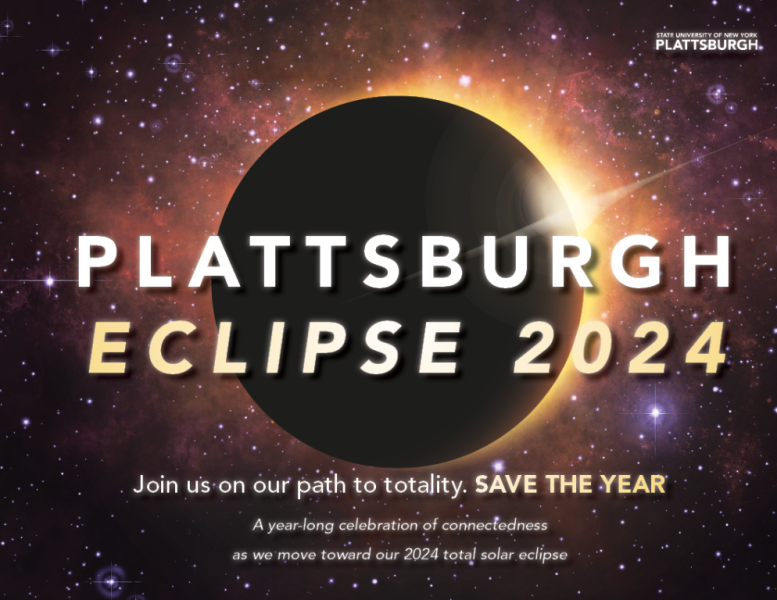2024 Eclipse Something to Celebrate at SUNY Plattsburgh

Illustration by Hannah Downs
It isn’t every day you find yourself in the swath of a total eclipse.
For professional and amateur astronomers, it’s kind of a big deal, so much so that SUNY Plattsburgh, which finds itself in that swath, is asking everyone to “Save the Year,” gearing up for a year-long celebration leading to the Monday, April 8, 2024 celestial event.
During a total solar eclipse, the moon’s shadow — its umbra — races across the surface of the Earth. Anyone within the path of totality — the path taken by the shadow of the moon as it crosses Earth — will experience a total eclipse, including SUNY Plattsburgh.
Once in Hundreds of Years
“Being on the path of totality doesn’t happen every day. You have to be in the right spot at the right time,” said Glenn Morello, lecturer in chemistry and biochemistry. “We will not see this again (over Plattsburgh) for maybe hundreds of years.”
The next one in North America won’t take place until 2044, and that’ll be over Montana and the Borderlands, said Lisabeth Kissner, director of the Northcountry Planetarium and lecturer in physics.
“To have an astronomical eclipse, to have a celestial body pass between us and the sun, which will block the sun’s light so that we experience more than three minutes of total darkness, is something to be celebrated,” she said.
And there are people who really go all out, said Genie Babb, associate dean of arts and sciences.
“There are hard-core eclipse watchers,” she said. “We (Plattsburgh) will be a regional place people can come and see it, wearing protective glasses of course.”
‘Bucket-list Item’
“It’s a bucket-list item,” Kissner said.
Morello agreed.
“This is a big event. There are places along the path of totality that host big events to bring people together to experience the eclipse. It’s really something to see, where you have crowds of people, all looking up, big smiles on their faces. It’s a thing,” he said.
And SUNY Plattsburgh wants to get in on the fun. A committee has been meeting regularly to make plans to include the eclipse experience in as many ways as possible, leading up to the big day in April.
Faculty and staff are being encouraged to develop curricula and programming that includes eclipse themes, from anthropology to video production, community living to the H.U.B. The possibilities are out boundless, they said.
For her part, among other things, Kissner is developing a Cardinal Seminar on “Astronomy in Society: Eclipses,” and hopes to include planetarium shows for campus and community.
Babb said they’re looking to bring notable experts to campus, including perhaps an astronaut.
Dr. David Levy
Dr. David Levy, who has personal connections to SUNY Plattsburgh and its Twin Valleys Education Center in Westport, is another hoped-for speaker. Levy, Montreal native and amateur astronomer who co-discovered the Shoemaker-Levy 9 comet, attended science camps at Twin Valleys as a teenager.
In addition, he received the SUNY Honorary Doctor of Science in 2005, had the Twin Valleys observatory named after him in 2010 and has returned to campus numerous times to give talks on how astronomy weaves into literature, music and more.
“As we approach fall 2023 and then spring 2024, we will be trying to get every department somehow contributing, whether it’s teaching a class that has to do with the eclipse or doing some eclipse-themed activity on campus,” Morello said. “We reaching out to all so it’s not just about making it scientific. It’s going to be really cool, and it can be appreciated from very different viewpoints.”
Across Curricula
“We want to ask, ‘What is your angle from your field?’” Babb said. “We would love to see podcasts, contests, maybe a showcase of artwork. We’ll be in touch with community groups as well to partner with us for the event.”
“Astronomy is an ancient science,” Kissner said. “It’s a connection to our present day with our ancestors who looked up at the sky, and a connection forward to our descendants — what they saw then, what we see now and what will be seen.”
— By Associate Director of Communications Gerianne Downs